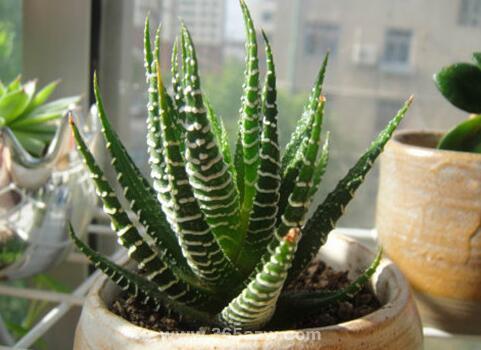Stripe twelve roll maintenance skills and precautions
Stripe twelve rolls is a kind of small plant similar to aloe vera. Many people like to breed a stripe twelve rolls potted at home. What are the maintenance skills of stripe twelve rolls? Let's take a look at it today.

An introduction to twelve volumes of stripes
Twelve stripes, also known as pheasant tail, get its name because its thick triangular lanceolate leaves are inlaid with banded white star patterns, shaped like the feathers of pheasant tails. Its thick leaves into a compact arrangement, fresh and elegant, delicate and beautiful shape, small and exquisite. The white stripes on the dark green leaves are in sharp contrast. Very shade-resistant, it is an ideal indoor small potted flower.
Morphological characteristics of twelve stripes
It is a perennial evergreen succulent plant of Liliaceae. The plant is small, exquisite, with green-white flowers and racemes. The fleshy leaves are arranged in a rosette with a plant width of 5~7cm. The leaf is long 3~4cm, wide 1.3cm, triangular lanceolate, acuminate, slightly erect, upper inner curved, leaf surface flat, leaf back protruding, keel-shaped, green, with large white verrucous protuberances, arranged with horizontal stripes.
The leaves are closely whorled on the stem axis, showing a rosette; the leaves are triangular-lanceolate, the apex is sharp, dark green, the surface is smooth, the back of the leaf is green, and the larger white nodule soil is arranged into horizontal stripes, which is in sharp contrast to the dark green foliage, which looks like a small pheasant tail.
How to make the stripes out of twelve rolls

Stripes 12 volumes of brocade way, one is manual intervention, the other is natural brocade, ordinary families still can not reach such a high technical level, can only let it naturally brocade. As long as a little attention is paid to the maintenance process, there is no problem with brocade.
Twelve volumes of stripes show brocade.
If you want the stripes to be rolled out of brocade, the environment should be strictly controlled during maintenance:
Twelve volumes like a warm and dry environment, resistant to drought and afraid of stagnant water. Strong light will make the leaf tip red and even scorched. On the contrary, the lack of light will make the plant shape scattered, affecting the ornamental.
So keep it in a place with bright light and no direct sunlight. Usually keep the basin soil dry to control the growth and maintain the perfection of the bonsai.
Thin fertilizer should be applied once a month in spring and autumn, ventilation should be paid attention to in summer, watering should be controlled in winter, and more than 5 ℃ can safely pass the winter.
Sufficient light conditions are needed in winter, and lack of light can easily lead to leaf degradation and shrinkage, which seriously affects the normal growth.
How about twelve stripes in brocade?
Generally speaking, the stripes twelve roll out of brocade, the leaves will appear yellow stripes, will be called brocade, such as orchid brocade leaf art, very beautiful.
Twelve stripes out of brocade will not affect its growth, but a different form of growth. If you like changeful, you might as well try to produce twelve rolls of two kinds of stripes in several kinds.

The flower language of twelve volumes of stripes: cheerful and lively
The twelve volumes of stripes belong to perennial succulent herbs of Liliaceae, which are native to the tropical arid regions of southern Africa. The leaves are closely whorled on the stem axis, showing a rosette; the leaves are triangular-lanceolate, apex acute; the leaf surface is smooth, dark green; the back of the leaf is green, with large white verrucous protuberances, which are arranged in horizontal stripes, in sharp contrast to the dark green of the leaf surface. It has good ornamental value.
Striped rolls like a warm, dry and sunny environment. For fear of low temperature and humidity, the suitable temperature during the growing period is 6 ℃ 18 ℃, the following March 10 ℃, and the lowest temperature in winter is no less than 5 ℃. The requirement to the soil is not strict, and the fertile and loose sandy loam soil is suitable.

The above is the 12 volumes of stripes maintenance skills introduction, I hope to help you.
Related
- Wuhan Hospital Iron Tree Blooming Result Was Instantly Frightened by the Gardener Master
- Which variety of camellia is the most fragrant and best? Which one do you like best?
- What is the small blue coat, the breeding methods and matters needing attention of the succulent plant
- Dormancy time and maintenance management of succulent plants during dormancy
- Minas succulent how to raise, Minas succulent plant pictures
- What are the varieties of winter succulent plants
- How to raise succulent plants in twelve rolls? let's take a look at some experience of breeding twelve rolls.
- Attention should be paid to water control for succulent plants during dormant period (winter and summer)
- Watering experience of twelve rolls of succulent plants
- Techniques for fertilizing succulent plants. An article will let you know how to fertilize succulent plants.



